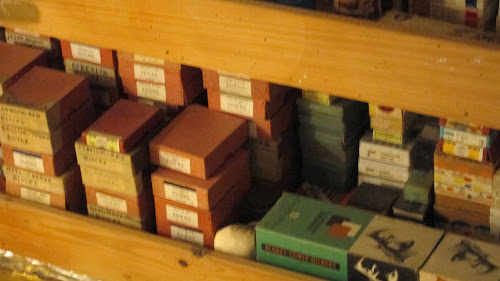Paris, as Hemingway wrote, is a moveable feast, which is why I ended up handing out water bottles to Canadian runners during the Paris Marathon. It all started out innocently enough, the Latin Quarter,
Notre Dame, Sainte Chapelle,
a short walk over the bridge to Shakespeare & Co. to see which authors were reading. Shakespeare & Co. is my favorite bricks and mortar bookstore on the planet. This is probably true of almost anyone who has come here.
The first level has floor to ceiling shelves of books, all for sale, all in English and mostly literature, though there is a modest selection of everything else as well. The second floor is also floor to ceiling books, but not for sale, being a sort of library for the highly literate, and those who aspire to write.
There are a few spaces with, of all things, typewriters, and many places to sit or sprawl and read. The people who have written, read or stayed at one or other iteration of this bookstore include James Joyce, Ernest Hemingway, Gertrude Stein, Scott Fitzgerald, Ezra Pound, Ford Madox Ford and later, at this particular location, William Burroughs, Allan Ginsberg, and many other Beat Generation writers.
As well there is a piano. Anyone can come in off the street and hang out as long as they like, write a novel, play the piano, it's all very casual and happening and intelligent and it's possible to meet people who are astonishingly gifted. It is pretty much terra sancta with regards to who has spent time upstairs writing or who has spent time downstairs reading.
It was here that I met Nubilia, who was singing some Beatles tunes for a few Brits that were milling about. She had a lovely, if untrained voice, and singing English lyrics with an Italian accent added to the charm. Suddenly the pianist had to leave, and the Brits didn't leave, and I asked her if she knew any Pink Floyd, and she said she was a huge fan, so I sat in and played through most of the vocal numbers from Dark Side of the Moon, ending with Great Gig in the Sky. Nubilia did a brilliant job of the vocalise, so much so that a bunch more people gathered. I wanted to stop but everyone cheered us on, so after a bit of consultation we did a couple of Elton John numbers, then ended with the Louis Armstrong classic, Wonderful World. Someone asked if we took requests, and I looked at her and she looked at me and I just knew this was coming, "Do you know any Doors?" came the question from someone with a decidedly non-British accent. "Only if you'll sing along" I said, and that's exactly what happened, with a chorus of American, French, Italian, African, British, Canadian, Dutch, and probably many other nationalities singing Break on Through, Love Her Madly, Love Me Two Times, and so on... A curious thing happened as I was just getting into the extended keyboard solo on Light My Fire; a dude pulled up a chair and started improvising on top of my bass line, something very funky and in keeping with the piece, but this guy was really pounding some solid jazz chords. He motioned me to keep jamming, which I did, and he went off on some wacky wild tangent totally in keeping with the psychedelic-nightmare-carnival-keyboard-style of Ray Manzaric but also very jazzy. We probably extended that solo section to almost 20 minutes, then we each signaled that we should probably bring it home, and as I started in on the recap of the familiar riff, he played it as well but in Blues block chords, all very hyper cool! Then everyone sang the final verse, and there was huge applause, now the crowd being quite packed in and spilling down the narrow stairs. This was absolutely hilarious and we were all having a really intense fun time and I asked him where he was from. As it turns out Nathan is a jazz pianist from Montreal, and was here to accompany his girlfriend and a bunch of other Canadians who were running the Paris Marathon the next day. He played a couple more numbers solo, his own compositions, very cool and mellow blues, then when the group had thinned a bit we decided to all have lunch at the bistro next door. Despite my initial reluctance because I noticed the menu boards were in English, they assured me this place was cool, and it was. I guess I should stop being so paranoid about how Parisians treat tourists... They asked if I'd like to help hand out water to Canadians participating in the run tomorrow, and I said sure, and that's how I spent the next morning, on the lower banks of the Seine, looking out for shirts that had a red maple leaf on them and helping out with the distribution of water bottles. The things that happen in Paris...
I spent a great deal of time visiting galleries and museums, mostly studying paintings. The Louvre, unlike D'Orsay, has a very enlightened policy on taking pictures: knock your socks off, but no flash, which is very civilized indeed, considering the tumultous history of some of these paintings. While I took a few overall pictures of some paintings, mostly I took lots of extreme close ups, especially of some of my favorites, like the Vermeers. I hope in the future that museums will publish extremely high resolution pictures on-line so that aspiring painters can study them without having to travel vast distances. Nevertheless, the experience of actually seeing an important painting close-up is a tremendous luxury. From studying these paintings in art books one soon forgets how huge some of these are, like the Gericoult,
or how tiny, like Vermeer's Lacemaker, which is not much more than 7" square.
Needless to say I did not spend any time milling about trying to get a first row picture of the Mona Lisa.
This one is definitely worth seeing on-line or in high grade close-up in an art book. Still, as a cultural icon it is important to some people, a great many people, in fact, and this has the benefit of leaving all of the rest of Leonardo's works uncrowded. The recently discovered Prado copy of the Mona Lisa by one of Leonardo's Spanish apprentices is here at the special St. Anne exhibition which is on through May, and that copy is far more instructive with respect to the original in terms of colors, the background, the chair she's sitting on, her clothes, etc. Studying this painting one realizes just how damaged the original is, after hanging in King Louis' personal bathroom for many years. When the oils darkened someone took a scrub brush to it and took off her eyebrows. During the 19th century it was stolen, but eventually recovered, and every time the painting is taken down for cleaning, Paris holds its breath.
No visit to Paris would be complete without a walk up to Montmartre, and especially handy for me because that is where my hotel is.
The area is famous for all the painters that have lived and worked here, and many famous Impressionist works depict the area. Though there are still many painters who work here, they are by and large pretty lackluster, and I really wonder who it is that actually buys these paintings; tourists obviously, but why? Do they really not know any better? If so, why even come to Paris?
Maybe that's something I could do when I retire, live here and paint really bad Impressionist paintings for tourists.
Some more random photographs of the many hundreds I have taken can be found here.























































